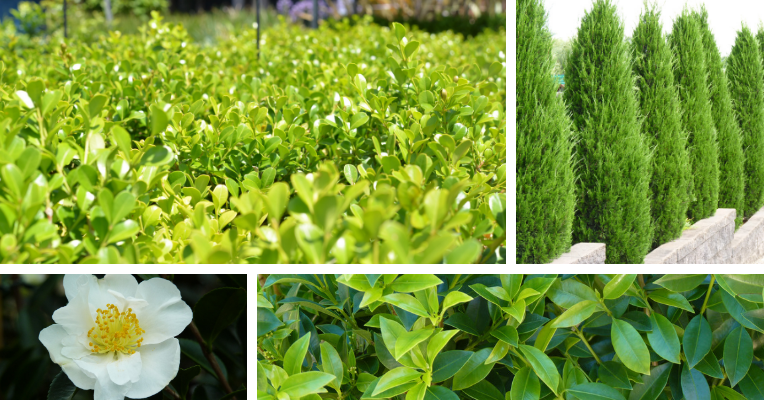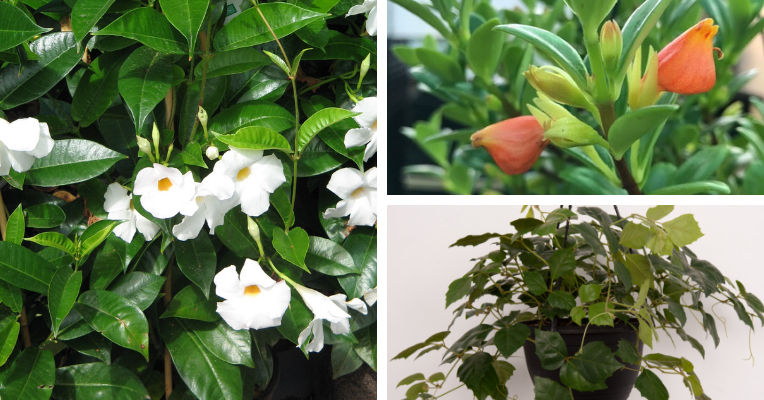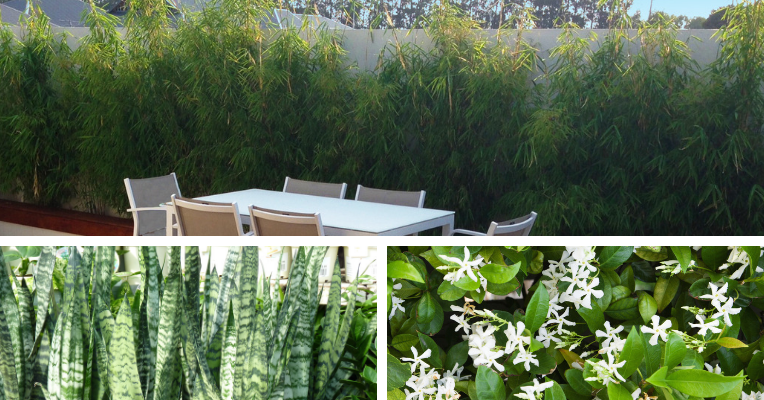Privacy Plants for Balconies
Do you have a balcony you don’t use because it’s overlooked? Perhaps you feel too exposed or uncomfortable to relax on your balcony, and this lack of privacy is why you never venture out! The right plants can transform an under-used and over-exposed balcony, sheltering it from the elements as well as from prying eyes.
Plants act as green screens, windbreaks or give shade and shelter. As well, they soften a harsh space and make it seem restful and safe. Plants can also look good from inside looking out.

Clockwise from top left: Coprosma Pacific Sunset, Rhaphiolepis Indica, Frangipani.
Choosing your pot
The main thing to remember when setting up privacy plants on a balcony is that they must be planted in large, sturdy containers that won’t tip over or blow away. Privacy plants need to be lush and bushy to be effective, which means they can blow over. To grow and keep healthy and leafy they need plenty of space to form a strong root system and enough potting mix around their roots to hold plenty of water and so avoid constant drying out. If a plant does dry out rapidly or blows over, re-pot it into a larger container. If a climbing plant is being used to cover a trellis for privacy, it too needs to be in as large a container as possible to support its growth.
As a general guide, select round pots that are at least 40-60cm across or rectangular planters that are 1-2m long for privacy plantings. For best growth plant just one plant per container for a round pot or several plants can grow well in a long rectangular planter. A large pot also adds extra height to even a compact plant meaning that privacy can be achieved quite easily by nesting a chair beside a potted plant.

Clockwise from top left: Japanese Box, Spartan Juniper, Lilly Pilly 'Hinterland Gold', Camellia Sasanqua 'Setsugekka'.
External elements
Next assess the light levels. Plants that are labelled as needing full sun grow best on a balcony that’s north facing with at least six hours of sunlight per day (preferably from the morning to early or mid afternoon). If the balcony gets little direct light look for shade-loving or indoor plants. The toughest situation is a west-facing balcony as these plants only get late afternoon sun. Succulents including frangipani work well in these exposed situations. You could also grow a shade-loving climbing plant on the sheltered side of a screen.
Finally consider how windy the balcony is. Plants with large leaves become tattered if constantly exposed to wind. Lush or soft foliage also gets burnt or dried out. A plant with a single stem or trunk could also be easily damaged. Multi-branched, small-leafed shrubs are the best choices on a windy balcony. Select plants such as Indian hawthorn (Rhaphiolepis indica) or coprosma (Coprosma ‘Pacific Sunrise’ or C. ‘Pacific Sunset’). These plants also tolerate part shade.

Clockwise from left: Mandevilla, Goldfish Plant and Grape Ivy 'Ellan Danica'.
Plant choices
The fastest way to get privacy is to invest in advanced evergreen plants in large containers. Dense evergreens such as lilly pillies and conifers such as ‘Spartan’ juniper work well for year-round privacy and can be grown successfully in a large container. Also suited to tall evergreen screening on a balcony are sasanqua camellias, Indian hawthorn (Rhaphiolepis indica), Japanese box (Buxus microphylla) and any of the coprosmas.
For a fast effect in a narrow space, use a clumping bamboo. Bamboo works well where there’s only room for a narrow planting. To keep bamboo leafy and growing it must be well watered. For a lower screen (under 1m high) but one that’s totally drought proof in sun or shade, try mother in law’s tongue (Sanseviera trifasciata), which can be grown in a trough.

Clockwise from top: Bamboo used for screening, Chinese Star Jasmine and Mother-in-law's Tongue.
A trellis covered with an evergreen climber is also useful for screening when only a narrow planting space is available. The trellis can be traditional lattice, wire or cut metal. To add greenery, plant star jasmine (Trachelospermum jasminoides) or white mandevilla (Mandevilla ‘White Fantasy’) to twine up the screen. Both plants need sun for at least part of the day and grow best in a large container that can support their growth. In a shaded spot grow the goldfish plant (Columnea x banksia), which has small orange flowers and glossy green leaves. Grape ivy (Cissus antarctica) is another low-light climber to select for a shaded balcony.
While hedge or screen plantings create a privacy barrier, large, leafy plants give shelter that’s more akin to sitting under an umbrella. Palms work well used in this way as they can bring height as well as lushness to an outdoor space, provided it’s sheltered from strong winds. Any palm that’s suited to use indoors in a container will work well on a balcony especially golden cane palm (Dypsis lutescens) and rhapis palm (Rhapis excelsa) which are both clumping palms. To gain privacy, simply plant the palm in a large container. If space permits, use two or more potted palms to create a tiny tropical oasis.

Golden Cane and Rhapis Palms make excellent privacy and shade plants for balconies.

